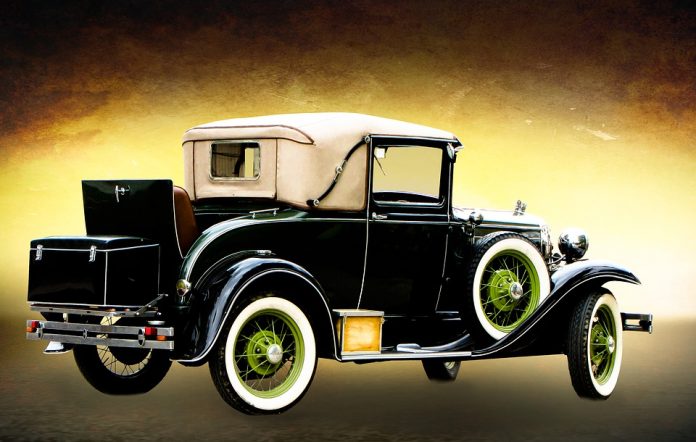1771 France – Nicolas-Joseph Cugnot’s second steam-powered vehicle is said to have crashed into a wall during a test run, in what would have been the first automobile accident. However, it is disputed that this ever happened. According to Georges Ageon the earliest mention of this occurrence dates from 1801 and it does not feature in contemporary accounts.
The world’s first road traffic death involving a motor vehicle
August 31, 1869 UK (Ireland) – While riding as a passenger with relatives in an experimental steam car, Mary Ward was thrown from the car and fell under the wheels as it rounded a bend. This is believed the first recorded automobile death. The car was built by her cousins, the sons of William Parsons, 3rd Earl of Rosse.
Statistics for fatality rates before and after the introduction of the motor vehicle, for journeys
The British road engineer J. J. Leeming, compared the statistics for fatality rates in Great Britain, for transport-related incidents both before and after the introduction of the motor vehicle, for journeys, including those once by water that now are undertaken by motor vehicle: For the period 1863–1870 there were: 470 fatalities per million of population (76 on railways, 143 on roads, 251 on water); for the year 1963: 325 (10, 278, 37). Leeming concluded that the data showed that “travel accidents may even have been more frequent a century ago than they are now, at least for men“.
The first person to die in a petrol-engine car accident and the first pedestrian victim
17 August 1896 UK – Bridget Driscoll is the first person to die in a petrol-engine car accident, and the first pedestrian victim of an automobile accident in the United Kingdom. As she crossed the grounds of the Crystal Palace in London, she was struck by an automobile belonging to the Anglo-French Motor Carriage Company that was being used to give demonstration rides.
The first fatality of a driver recorded
25 February 1899 UK – Edwin Sewell and Major Richer are thrown from their vehicle on Harrow on the Hill, Middlesex, London, and killed. Sewell’s death is the first fatality of a driver recorded.
The first person killed by a car in the United States
13 September 1899 – Henry H. Bliss is the first person killed by a car in the United States.
Speeding
The first speed limit legislation was created in the United Kingdom with the Locomotive Acts (automobiles were in those days termed “light locomotives”). The 1865 Act introduced a UK speed limit of 10mph (16km/h) which was then reduced to 4mph (6km/h) in the country and 2mph (3km/h) in towns by the 1865 Act (the ‘red flag act’). The first person to be convicted of speeding is believed to be Walter Arnold of East Peckham, Kent, who on 28 January 1896 was fined for speeding at 8mph (13km/h). He was fined 1 shilling plus costs. Passage of the Locomotives on Highways Act 1896, which raised the speed limit to a “furious” pace of 14mph is celebrated to this day by the annual London to Brighton Veteran Car Run.
The London to Brighton Veteran Car Run is the longest-running motoring event in the world. The first run was in 1896, and has taken place most years since then. To qualify, the cars must have been built before 1905. It is also the world’s largest gathering of veteran cars – 443 started in 2005, 484 in 2009, compared to 37 starters in 1927, 51 starters in 1930 and 131 in 1938. It takes place, currently, on the first Sunday in November and starts at sunrise from Hyde Park, London and mostly follows the A23 road to finish at Brighton – a distance of 54 miles (87km). There are two official stops along the way: Crawley (for coffee) and Preston Park (in a suburb of Brighton). Preston Park is the official finishing point; the cars then proceed to Madeira Drive on the seafront, also the venue for Brighton’s other big motoring event, the Brighton Speed Trials. The organizers emphasize that the event is not a race – they do not even publish the order in which cars finish, and participants are not permitted to exceed an average speed of 20mph (32km/h). Any that finish (many do not) before 16.30 are awarded a medal.
The Brighton Speed Trials, in full The Brighton National Speed Trials, is commonly held to be the oldest running motor race. The first race was held July 19–22, 1905 after Sir Harry Preston persuaded Brighton town council to tarmac the surface of the road adjacent to the beach between the Palace Pier and Black Rock in order to hold motor racing events. This stretch was renamed Madeira Drive in 1909 and the event is still held there, normally on the second Saturday of September each year. In 1936 Motor Sport described the event as: “undoubtedly the most important speed-trials on the British Calendar.”
The fastest speeding ticket in the world allegedly occurred in May 2003 in Texas. It was supposedly 242mph (389km/h) in a 75mph (121km/h) zone. The car was a Swedish-built Koenigsegg CC8S, which was involved in the San Francisco to Miami Gumball 3000 Rally.
The fastest convicted speeder in the UK was Daniel Nicks, convicted of 175mph (282km/h) on a Honda Fireblade motorcycle in 2000. He received six weeks in jail and was banned from driving for two years. The fastest UK speeder in a car was Timothy Brady, caught driving a 3.6-litre Porsche 911 Turbo at 172mph (277km/h) on the A420 in Oxfordshire in January 2007 and jailed for 10 weeks and banned from driving for 3 years.
The most expensive speeding ticket ever given is believed to be the one given to Jussi Salonoja in Helsinki, Finland, in 2003. Salonoja, the 27-year-old heir to a company in the meat-industry, was fined 170,000 euros for driving 80km/h in a 40km/h zone. The uncommonly large fine was due to Finnish speeding tickets being relative to the offender’s last known income. Salonoja’s speeding ticket was not the first ticket given in Finland reaching six figures.
There are many competing claims as to the first speeding ticket ever issued depending whether the claim goes by the first traffic violation or the first paper ticket ever issued. Great Britain may have the earliest claim with the first person to be convicted of speeding, Walter Arnold of East Peckham, Kent, who on 28 January 1896 was fined for speeding at 8mph (13km/h) in a 2mph (3.2km/h) zone. He was fined 1 shilling plus costs. A New York City cab driver named Jacob German was arrested for speeding on May 20, 1899 for driving 12 miles per hour on Lexington street in Manhattan. In Dayton, Ohio, police issued a paper ticket to Harry Myers for going twelve miles per hour on West Third Street in 1904.
Another early speeding ticket was issued in 1910 to Lady Laurier, the wife of Wilfrid Laurier, Prime Minister of Canada, in Ottawa, Canada, for exceeding the 10 miles per hour speed limit.
Among the most unpopular tickets, a mention is deserved of the small municipality of Segrate arranging to put a speed limit between two near-by traffic lights synchronized such that drivers were forced to either break the speed limit or pass with the red. It took months before the hated machines were eventually dismantled by the Guardia di Finanza
Drinking & Driving
One of the first reported criminal cases regarding drinking and driving in Canada was an Alberta decision in 1920 called R. v. Nickle. In that case, the appeal court found that the act of driving while intoxicated was an unlawful act that could support a manslaughter conviction.
In 1921, the Parliament of Canada first created a summary conviction offence for drinking and driving, called “driving while intoxicated”. At the time, the courts interpreted intoxication to mean substantial inebriation, and more than just being under the influence of alcohol. The minimum penalty for the first offence was seven days in jail. The minimum penalty for the second offence was one month in jail. The minimum penalty for a third offence was three months in jail.
In 1925, Parliament amended the Criminal Code of Canada to include a new offence of driving while intoxicated by a narcotic. The offences were also amended to include “care or control” of a motor vehicle, not just driving.
In 1930, Parliament changed the offence to a hybrid offence, giving the Crown the option to proceed with the more serious indictable offence procedure.
Difficulties arose regarding how to prove someone was in care or control of a motor vehicle, and what the test should be. In 1947, Parliament amended the Criminal Code again, adding a presumption of care or control when a person was found sitting in the driver’s seat of a motor vehicle. This did not answer all of the problems regarding the test (i.e. when a person is not found in the driver’s seat of a motor vehicle). Many of the court’s answers to those questions remain in conflict today.
In 1951, Parliament re-worded the law, making it an offence to operate or have care or control of a motor vehicle while the driver’s ability to operate the motor vehicle was impaired by alcohol or drug.
The breathalyzer was made into a practical police tool by Robert Borkenstein in 1952, which allowed for the police to measure a person’s blood alcohol concentration. The first Canadian test of the breathalyzer was in Ontario in 1954. By 1962, police were using the breathalyzer for “mass testing”. However, the test was voluntary, and could only be used as confirmatory evidence.
In 1969 (fifteen years after the introduction of the breathalyzer into Canada), Parliament created an offence of driving while “over 80” (over 80 milligrams of alcohol per 100 millilitres of blood). In 1976, Parliament made the penalty the same as driving while impaired, created the offence of refusing to provide a breath sample (with the same penalties), and created laws allowing the police to use roadside screening devices.
After 1976, there were additional changes to the minimum penalties, and the introduction of new offences (impaired driving causing bodily harm and impaired driving causing death).
By 2008, drinking and driving cases made up 12 per cent of all criminal charges, making it the largest single offence group. In 2008 it was estimated that 53,000 drinking and driving cases are heard every year in Canada. The conviction rate was 73 per cent, which exceeded the rate for all criminal convictions by 13 per cent. Notwithstanding the higher rate of conviction, drinking and driving cases are more likely to go to trial than any other criminal offence, and are often fought on both technical issues and alleged police violations of section 8, section 9, and section 10(b) of the Canadian Charter of Rights and Freedoms.
2008 also saw the most recent amendments by Parliament to the law on drinking and driving. The Tackling Violent Crime Act came into force on July 2, 2008. The changes included adding new evidentiary restrictions on defendants trying to raise “evidence to the contrary” regarding the presumption of a person’s blood alcohol concentration, created mandatory standard field sobriety tests that can be requested by a police officer, created additional means to allow police officers to test for the possible presence of drugs in a driver’s body, increased the minimum sentences to their current level ($1000 fine for the first offence, 30 days in jail for the second offence, and three months in jail for the third offence), and created new offences for “over 80” causing death or bodily harm and refusing to provide a sample where operation caused death or bodily harm

















